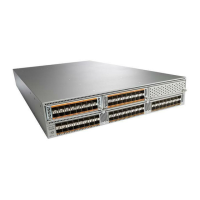Send feedback to nx5000-docfeedback@cisco.com
1-3
Cisco Nexus 5000 Series Switch CLI Software Configuration Guide
OL-16597-01
Chapter 1 Configuring and Managing VSANs
Information About VSANs
Figure 1-2 Example of Two VSANs
The four switches in this network are interconnected by VSAN trunk links that carry both VSAN 2 and
VSAN 7 traffic. You can configure a different inter-switch topology for each VSAN. In Figure 1-2, the
inter-switch topology is identical for VSAN 2 and VSAN 7.
Without VSANs, a network administrator would need separate switches and links for separate SANs. By
enabling VSANs, the same switches and links may be shared by multiple VSANs. VSANs allow SANs
to be built on port granularity instead of switch granularity. Figure 1-2 illustrates that a VSAN is a group
of hosts or storage devices that communicate with each other using a virtual topology defined on the
physical SAN.
The criteria for creating such groups differ based on the VSAN topology:
• VSANs can separate traffic based on the following requirements:
–
Different customers in storage provider data centers
–
Production or test in an enterprise network
–
Low and high security requirements
–
Backup traffic on separate VSANs
–
Replicating data from user traffic
• VSANs can meet the needs of a particular department or application.
FC FC FC FC
H1
H3H2
AS1 AS2 AS3
SA1 SA2 SA3 SA4
Link in VSAN 2
Link in VSAN 7
Trunk link
79533

